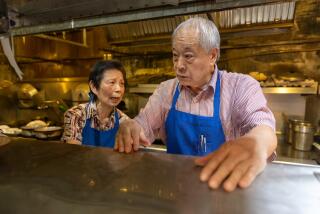Chinese history finds a spacious new home
- Share via
NEW YORK — In cramped tenement-like quarters in Chinatown, staff at the Museum of Chinese in America had to be careful not to step on any schoolchildren as they taught a class about the role Chinese immigrants played in building the transcontinental railroad.
For years, they dreamed of a bigger space to work with. That dream will come true when their new facility opens Sept. 22.
The 14,000-square-foot space, six times bigger than its original home, was designed by Maya Lin, creator of the Vietnam Veterans Memorial in Washington, and touted by some big-name movers and shakers, including “Brokeback Mountain” director Ang Lee, architect I.M. Pei, cellist Yo-Yo Ma and playwright David Henry Hwang.
But despite the big names attached to the $8.1 million project, the museum is run by a small staff of nine, including newly appointed director S. Alice Mong.
“We are a very lean organization,” Mong said. “As you can see, there’s no fat.”
For nearly 30 years, the museum has been in a 2,000-square-foot space at 70 Mulberry St. on the second floor of a 19th-century schoolhouse. There is no way to feature the hundreds of documents and objects collected over the years, sharing the history and culture of Chinese immigrants in America and the role their descendants played in helping construct American society.
With the new space, there is more room for the vast collection, a bigger staff and a growing fan base. There are nearly 4 million Chinese Americans in the United States.
“It’s our story,” said Mong, who emigrated with her family from Taiwan in 1973. “There isn’t another national museum for Chinese Americans. We hope to be a cultural anchor not only for the local Chinese in New York but for Chinese across the United States and around the world.”
The new museum, converted from an industrial machine repair shop on Centre Street, features a skylit courtyard reminiscent of those found in the center of a traditional Chinese home. In the front lobby is an art installation called “The Journey Wall,” which consists of bronze tiles that show where Chinese American families came from and where they settled in the United States.
Fundraising for the new space began in 2004, spearheaded by museum co-founder Charles Lai.
“Having this new facility gives us the legitimacy and the credibility we have always sought,” Lai said. “It allows people to realize that together with our wonderful programs and strong content, we are worthy of a higher level of support.”
So far, the museum has raised $12 million, and Mong said it is well on the way to reaching its $15 million goal. Mong said the museum is in good financial shape because fundraising began long before the economy went bad. So far, all donors have come through with their promised pledges.






